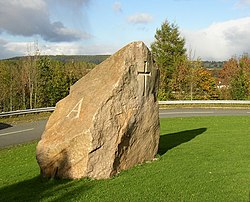Eamont Bridge
| Eamont Bridge | |
| Westmorland | |
|---|---|
 The Eden Millennium Monument | |
| Location | |
| Grid reference: | NY526282 |
| Location: | 54°38’50"N, 2°44’7"W |
| Data | |
| Postcode: | CA10 |
| Local Government | |
Eamont Bridge is a small village on the River Eamont in Westmorland immediately to the south of Penrith. The river here forms the border between the counties of [[Westmorland] to the south and Cumberland to the north and so the houses of the village which stands by the north end of the bridge are in Cumberland.
A few yards further north the A66 dual carriageway slices across the land with a large roundabout junction, beyond which is the town of Penrith. The M6 motorway carves its path northward just to the west of the village, but Eamont Bridge itself manages remains a calm and attractive little place. Apart from the dual carriageway and motorway, Eamont Bridge and Pooley Bridge have the only road bridges over the Eamont below Ullswater.
The River Lowther flows northwards coming from the fells, and takes a sudden eastward sweep at the edge of Eamont Bridge, to enter the Eamont a mile downstream; the village thus stands in the mouth of a tongue of land between the rivers
There are two pubs opposite each other at the southern end of the village. One of the houses in the village is called the "Welcome Inn" and was at one time the Welcome into Cumberland Inn.
The village is on the A6 road and before the opening of the M6 motorway was a notorious bottleneck due to the narrow bridge over the River Eamont which is still today controlled by traffic lights.
Name
The Anglo-Saxon Chronicle describes a summit of kings æt Eamotum, whc=ich is usually taken to mean Eamont Bridge. Æt Eamotum means "at the meeting of rivers", which may be anywhere, though other sources suggest Eamont or its locality and this may refer to the joining of the Lowther and the Eamont. The river then may be named after the village not the village from the bridge and the bridge from the river.
History and ancient sites
There are two ancient sites in the village, namely the earthwork known as King Arthur's Round Table and the much better preserved Mayburgh Henge which is situated between the rivers Lowther and Eamont. Mayburgh Henge was built using stones from one or both rivers.
The situation between rivers gives a defensive position, no doubt important when the henge was built 3000 or 4000 years ago, and was also thus protected from invasion. Both sites are under the protection of English Heritage. There was another henge close to King Arthur's Round Table, now obliterated. A cup was reputed to have been found at the centre of the King Arthur's Round Table Henge. The gateway from Mayburgh Henge points in the direction of King Arthur's Round Table, which was probably a convenient meeting place for milennia. There are several more henges in the area, with at least two towards the north east, towards Brougham, visible.
There is a splendid example of vernacular architecture in the centre of the village: the Mansion House.
On 12 July 927, Eamont Bridge is believed to have been was the scene of a gathering of kings from throughout Britain. This meeting is recorded in the Anglo-Saxon Chronicle at taking place æt Eamotum, and the histories of William of Malmesbury and John of Worcester. William however says it took place ad locum qui Dacor uocatur ("at the place which is called Dacre"); which would is further upstream. Eamont Bridge may then have been at the border of England with Strathclyde. Present according to old sources were Athelstan King of the English, Constantine King of the Scots, Owain King of Strathclyde, Hywel King of Wales ("Hywel Dda"), and Ealdred High Reeve of Bamburgh. The kings agreed peace between them, the overlordship of Athelstan and to forbid pagan practices throughout their realms. Constantine and Owain took arms against Athelstan in 937 however and were defeated at Brunanburh, restoring the position settled at Eamont.
The Eden Millennium Monument, a 50 ton inscribed stone, was placed overlooking Eamont Bridge in 2000.
Outside links
| ("Wikimedia Commons" has material about Eamont Bridge) |
